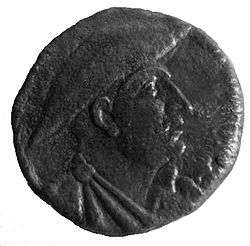Bassania
Bassania was an ancient Illyrian city whose inhabitants may have been hellenised.[1] It lies in modern Bushat village within the Shkodër County and was very close to the ancient Greek colony of Lissus, in modern Albania. The ruins of the City extended in a surface three times of the ancient ruins of Shkoder (nearest city), massive stone walls surrounded an area of about 20 hectares, were discovered by a Team of Polish-Albanian Archaeologists in 2018. The city wall is massive. Measuring 3 meters thick, the wall is made from huge stone blocks packed tightly against each other. In between the stone blocks are earth and small stones filled in to close off any gaps. Ancient coins and portions of ceramic artifacts recovered near the walls date back to the 4th to 1st century BC, providing further confirmation of the age of the city ruin. Bassania fell into Roman hands during the reign of Octavian Augustus at the turn of the 1st century AD and was promptly destroyed or abandoned.
.svg.png)
See also
References
- Wilkes, J. J. The Illyrians, 1992, ISBN 0-631-19807-5, page 174 "... 174 Greek lllvrians Bassania, a town under Roman control. This Illyrical City was described from Roman Historian, Livio (59 b.C. – a.C. 17) in the battle between Romans Troops and the Illyrians guided by Last Illyrian King, Gentius. Gentius Anicius was based at Apollonia where, in addition to Roman forces, there were 2000 infantry ..."
Bibliography
- Wilkes, J. J. The Illyrians, 1992, ISBN 0-631-19807-5
External links
| Wikimedia Commons has media related to Illyria & Illyrians. |
